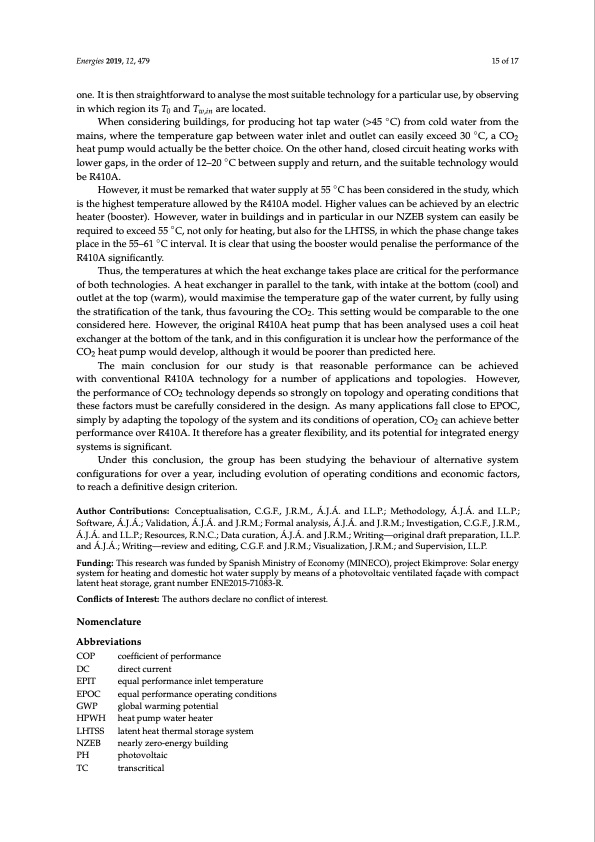
PDF Publication Title:
Text from PDF Page: 015
Energies 2019, 12, 479 15 of 17 one. It is then straightforward to analyse the most suitable technology for a particular use, by observing in which region its T0 and Tw,in are located. When considering buildings, for producing hot tap water (>45 ◦C) from cold water from the mains, where the temperature gap between water inlet and outlet can easily exceed 30 ◦C, a CO2 heat pump would actually be the better choice. On the other hand, closed circuit heating works with lower gaps, in the order of 12–20 ◦C between supply and return, and the suitable technology would be R410A. However, it must be remarked that water supply at 55 ◦C has been considered in the study, which is the highest temperature allowed by the R410A model. Higher values can be achieved by an electric heater (booster). However, water in buildings and in particular in our NZEB system can easily be required to exceed 55 ◦C, not only for heating, but also for the LHTSS, in which the phase change takes place in the 55–61 ◦C interval. It is clear that using the booster would penalise the performance of the R410A significantly. Thus, the temperatures at which the heat exchange takes place are critical for the performance of both technologies. A heat exchanger in parallel to the tank, with intake at the bottom (cool) and outlet at the top (warm), would maximise the temperature gap of the water current, by fully using the stratification of the tank, thus favouring the CO2. This setting would be comparable to the one considered here. However, the original R410A heat pump that has been analysed uses a coil heat exchanger at the bottom of the tank, and in this configuration it is unclear how the performance of the CO2 heat pump would develop, although it would be poorer than predicted here. The main conclusion for our study is that reasonable performance can be achieved with conventional R410A technology for a number of applications and topologies. However, the performance of CO2 technology depends so strongly on topology and operating conditions that these factors must be carefully considered in the design. As many applications fall close to EPOC, simply by adapting the topology of the system and its conditions of operation, CO2 can achieve better performance over R410A. It therefore has a greater flexibility, and its potential for integrated energy systems is significant. Under this conclusion, the group has been studying the behaviour of alternative system configurations for over a year, including evolution of operating conditions and economic factors, to reach a definitive design criterion. Author Contributions: Conceptualisation, C.G.F., J.R.M., Á.J.Á. and I.L.P.; Methodology, Á.J.Á. and I.L.P.; Software, Á.J.Á.; Validation, Á.J.Á. and J.R.M.; Formal analysis, Á.J.Á. and J.R.M.; Investigation, C.G.F., J.R.M., Á.J.Á. and I.L.P.; Resources, R.N.C.; Data curation, Á.J.Á. and J.R.M.; Writing—original draft preparation, I.L.P. and Á.J.Á.; Writing—review and editing, C.G.F. and J.R.M.; Visualization, J.R.M.; and Supervision, I.L.P. Funding: This research was funded by Spanish Ministry of Economy (MINECO), project Ekimprove: Solar energy system for heating and domestic hot water supply by means of a photovoltaic ventilated façade with compact latent heat storage, grant number ENE2015-71083-R. Conflicts of Interest: The authors declare no conflict of interest. Nomenclature Abbreviations COP coefficient of performance DC direct current EPIT equal performance inlet temperature EPOC equal performance operating conditions GWP global warming potential HPWH heat pump water heater LHTSS latent heat thermal storage system NZEB nearly zero-energy building PH photovoltaic TC transcriticalPDF Image | Comparison of Transcritical CO2 and Conventional Refrigerant Heat Pump

PDF Search Title:
Comparison of Transcritical CO2 and Conventional Refrigerant Heat PumpOriginal File Name Searched:
energies-12-00479.pdfDIY PDF Search: Google It | Yahoo | Bing
CO2 Organic Rankine Cycle Experimenter Platform The supercritical CO2 phase change system is both a heat pump and organic rankine cycle which can be used for those purposes and as a supercritical extractor for advanced subcritical and supercritical extraction technology. Uses include producing nanoparticles, precious metal CO2 extraction, lithium battery recycling, and other applications... More Info
Heat Pumps CO2 ORC Heat Pump System Platform More Info
| CONTACT TEL: 608-238-6001 Email: greg@infinityturbine.com | RSS | AMP |